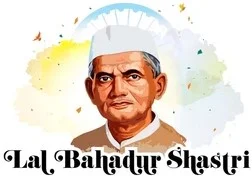Who Is LaL Bahadur Shastri
Lal Bahadur Shastri: A Brief Personal Account
Lal Bahadur Shastri was the second Prime Minister of India from 1964 till his premature death in 1966. His values and personality are defined by his humility, simplicity, and great authority at critical junctures of India’s past.
 |
| Lal Bahadur Shastri |
Key Contributions and Awards:
- Jai Jawan, Jai Kisan: This famous slogan, which literally translates to 'the soldier is respected, the farmer is respected’, was devised by Shastri to convey the significance of defense and agriculture for the country’s development and welfare.
- 1965 Indo-Pak War: He ably took charge of the country and guided it through the 1965 war with Pakistan displaying great will and leadership.
- Green Revolution: To Shastri, the Green Revolution increased agricultural output and food security in India.
- White Revolution: He advocated the growth of dairy farming in India.
Awards:
- The Bharat Ratna, India’s highest civilian award, was given to him in 1966, shortly after his death.
- Shastri’s leadership was characterized by great simplicity, a no-nonsense approach, and concern for national progress and self-sufficiency.
Lal Bahadur Shastri: Childhood and Personal Life
Lal Bahadur Shastri was one of the most prominent Indian leaders whose influence persists even after many decades.
- He was born on the 2nd of October in 1904 at Mughalsarai, which is in Uttar Pradesh.
- The father of Lal Bahadur, Sharada Prasad Srivastava, was a school teacher.
- While his mother, Ramdulari Devi, was a stay-at-home wife.
- He was very young when his father passed away and his mother brought him up in a very modest and poor environment.
Education:
Shastri refused to use his caste surname, ‘Srivastava’ out of disgust for the caste system.
- People’s Education Society (PES) was Nagpur’s first Marathi primary school which started two years earlier before the establishment of the school.
- He graduated from Kashi Vidyapeeth where he was conferred the title of Shastri, which means scholar.
Personal Life:
- He married Lalita Devi in 1928 and fathered six children.
- Shastri’s ascetic lifestyle was a byproduct of his philosophy and ethics; he was a follower of Mahatma Gandhi’s policy of non-violence and serving one’s motherland.
- The early life adversity of Shastri made him modest and hard-working trait which was evident through his values as a leader and as a person.
Research Ability/ Political Career:
- Shastri was a freedom fighter who also took part in the Non-Cooperation Movement and was imprisoned by the British once again.
- After independence, he was appointed as Minister of Transport where he brought women conductors into the fold and enhanced the public transportation system.
- He became the Home Minister afterward and was involved in restructuring the police forces of the states and dealing with internal affairs.
- In 1964, Shastri became the Prime Minister of India succeeding Jawaharlal Nehru.
Conspiracy Theories Around the Death of Lal Bahadur Shastri
- Lal Bahadur Shastri passed away mysteriously on January 11, 1966, in Tashkent, Uzbekistan.
- Just a few hours after he had signed the Tashkent Agreement with Pakistan which was meant to bring an end to the war fought between the two countries in 1965.
- It was stated officially that Shastri died of heart failure, but over time several conspiracy theories have emerged questioning the reasons behind the death of Shastri.
Key Theories:
Allegations of Poisoning:
- Even family members of Shastri including his wife Lalita Devi pondered foul play in Shastri’s death. They pointed out that an autopsy was not performed and noted blue blotches on his body which can sometimes indicate poisoning instead of natural causes of death.
- Dr. R.N. Chugh, his personal physician was not in his quarters at that time which cast even more doubts on their claims.
Mysterious Death of Key Witnesses
- Dr. R.N. Chugh and another assistant who was in to give in the testified support if she was alive, Ram Nath met with dead-end road accidents suspiciously with the trust of a cover-up.
Involvement of Foreign Powers
- Some people have assumed the CIA or KGB to be in the picture due to the Cold War scenario and Shastri's fight for non-alignment. This succeeded in creating better divisions in their ranks, although others think it may have been just a political conspiracy.
- His trip to Tashkent overlapped many domains of political importance for India, the erstwhile USSR, and Pakistan.
Lack of Definitive Proof:
- Over and above all, none of these allegations have been substantiated with any convincing proof. There is an official record of Shastri’s death attributing it to heart failure.
- However, the lack of a probe, post-mortem examination as well and selective suppression of relevant information by the state fuels distrust among conspiracy theorists and the general populace.
Frequently Ask Questions
What did Lal Bahadur Shastri do in his lifetime?
No one will argue that the slogan ‘Jai Jawan, Jai Kisan’ is the most recognized portion of Lal Bahadur Shastri’s legacy. It praised the nation’s farmers and soldiers while advocating that both sectors were critical to India’s development. Moreover, India was under his leadership during the 1965 Indo-Pak War and he was a proponent of the Green Revolution and its aim to enhance the country’s food supplies.
In what way did Lal Bahadur Shastri’s life come to an end?
Shastri died in Tashkent on January 11, 1966, after the conclusion of the Tashkent Agreement signing ceremony. While his death was officially declared to be due to a heart attack, many conspiracy theories have suggested that it was not the actual cause of death, with some claims citing poisoning as the cause.
How many Lal Bahadur Shastri prizes were given?
In 1966, Lal Bahadur Shastri was honored with the Bharat Ratna award which is the highest award a civilian can receive in India after he passed on for his services rendered to the nation.
Comments
Post a Comment